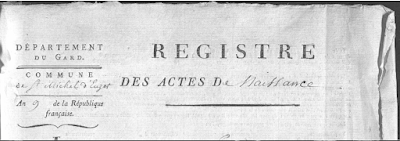Simon Boyer was the first Boyer to emigrate from France to Puerto Rico. He settled in Guayama in the 1830’s, with descendants in Guayama, Arecibo, Ponce, Mayaguez, Quebradillas, and Arroyo.
born: 22 Dec 1800 at Saint-Michel-d' Euzet, Gard, Francemarried Francisca Hortensia VEINTIDOS-ABRÓN (Vingt-Deux Abrart)died: 05 Jan 1852 at Guayama, PR
Simon's Parents are given in his domicile papers in Puerto Rico as Etienne BOYER (1768), Marie DEYDIER (1775)
Simon's Children: Augosto Eugenio "Agustin" BOYER-VEINTIDOS (1836) who married Francisca Emilia VIRELLA-RIVERA in Guayama on June 10, 1857. Maria Margarita BOYER-VEINTIDOS (1832), Maria Emilia BOYER-VEINTIDOS (1834), Juan Bautista BOYER-VEINTIDOS (1844) and Olivia Polonia BOYER-VEINTIDOS (1848).
Simon's grandchildren include: Adela BOYER-VIRELLA, Agustin BOYER-VIRELLA, Carmen BOYER-VIRELLA, Federico BOYER-VIRELLA, Simon BOYER-VIRELLA, Juan Rufino BOYER-COLON (1856)
In Simon’s domicile papers in Puerto Rico dated 1832, a copy of his birth was recorded, but they did not understand the year he was born and just wrote ‘illegible.’
The section reads:
El dia segundo del mes nivose del año —(ilegible) de la Republica Frances.
Acta de nacimiento de Simon Boyer, nacido el primero del mes, a las once de la mañana, hijo de Esteban Boyer, labrador, y de Maria Deydier, casados, habitantes del canton de San Miguel de Euzet, departamento de Gard…
The original record of his birth in Saint-Michel-d' Euzet, Gard, France states that he was born on the first of Nivôse and the birth was recorded on the second of the month of Nivôse in the IX or ninth year of the French Republican Calendar.
The French Republican Calendar was a calendar created and implemented during the French Revolution and used by the French government for about 12 years from late 1793 to 1805. On 21 September 1792, the French First Republic was proclaimed, and the new National Convention decided that 1792 was to be known as Year I of the French Republic. It decreed on 2 January 1793 that Year II of the Republic had begun the day before. However, the new calendar as adopted by the Convention in October 1793 made 22 September 1792 the first day of Year I. Consequently, the months and years of this French Republican Calendar do not align exactly with the Gregorian Calendar (the calendar we use today).
Years appear in writing as Roman numerals, with epoch 22 September 1792, the beginning of the "Republican Era" (the day the French First Republic was proclaimed, one day after the Convention abolished the monarchy). As a result, Roman Numeral I indicates the first year of the republic. Roman numeral IX is the 9th year of the Republic.
Months and days were also different than the Gregorian Calendar. There were twelve months, each divided into three ten-day weeks called décades.
Autumn:
Vendémiaire (from French vendange, derived from Latin vindemia, "vintage"), starting 22, 23, or 24 SeptemberBrumaire (from French brume, "mist"), starting 22, 23, or 24 October
Frimaire (From French frimas, "frost"), starting 21, 22, or 23 November
Winter:
Nivôse (from Latin nivosus, "snowy"), starting 21, 22, or 23 DecemberPluviôse (from French pluvieux, derived from Latin pluvius, "rainy"), starting 20, 21, or 22JanuaryVentôse (from French venteux, derived from Latin ventosus, "windy"), starting 19, 20, or 21 February
Spring:
Germinal (from French germination), starting 20 or 21 MarchFloréal (from French fleur, derived from Latin flos, "flower"), starting 20 or 21 AprilPrairial (from French prairie, "meadow"), starting 20 or 21 May
Summer:
Messidor (from Latin messis, "harvest"), starting 19 or 20 JuneThermidor (or Fervidor*) (from Greek thermon, "summer heat"), starting 19 or 20 JulyFructidor (from Latin fructus, "fruit"), starting 18 or 19 August
Understanding the terminology used in the French Republican calendar, it is clear that Nivôse is the 4th month in the French Republican Calendar and “an 9” is year IX of the French Republican Calendar on the birth document for Simon Boyer in France.
We then use a conversion table between the French Republican Calendar and the Gregorian Calendar. According to the conversion table below- he was born on the 1st of Nivôse an 9 or IX. This translates to Dec 22, 1800. He was registered on the 2nd of Nivôse, an 9 or IX- so registered on the 23rd of December, 1800.
All documents in France between the years 1793 and 1805 will use the French Republican Calendar and subsequently the dates will need to be converted to reflect the correct date in our Gregorian Calendar.
After converting the dates from his birth document to the Gregorian Calendar, we can verify his birth and registration as:
Birth- Dec 22, 1800Registered: Dec 23, 1800Saint-Michel-d' Euzet, Gard, FranceFather: Etienne BoyerMother: Marie Deydier
The parents of Simon BOYER were Etienne BOYER and Marie DEYDIER who married in Saint-Michel-d' Euzet, Gard, France on 08 Feb 1796. From this marriage we know that Etienne’s parents were Francois BOYER and Rose VEAUCLARE. Marie DEYDIER’s parents were Pierre DEYDIER and Marie FAUCHET.
Bibliography
- Archivo General de Puerto Rico Publ: Puerto Rico, registros parroquiales, Iglesia Católica, 1645-1969, Defunción, Guayama, LD- Folio 194, No s/n
- Puerto Rico, Registros de extranjeros, 1815-1845 Auth: National Archives and Records Administration Publ: Washington, DC Date: 1832 Locn: NARA microfilm T1170
- Actes paroissiaux et d'état civil de Saint-Michel d'Euzet (1598-1932) État civil Actes1793-an X, image #72
- https://en.wikipedia.org/wiki/French_Republican_calendar
- Conversion table source: https://en.wikipedia.org/wiki/Nivôse
- Actes paroissiaux et d'état civil de Saint-Michel d'Euzet (1598-1932) » État civil » Actes » 1793-an X, image #102-103















